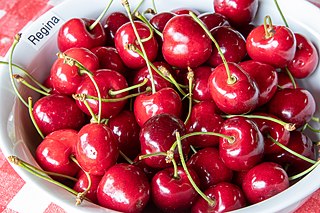Related Research Articles

A cherry is the fruit of many plants of the genus Prunus, and is a fleshy drupe.

Prunus cerasus is a species of Prunus in the subgenus Cerasus (cherries), native to much of Europe and southwest Asia. It is closely related to the sweet cherry, but has a fruit that is more acidic. Its sour pulp is edible.

The tangelo, Citrus × tangelo, is a citrus fruit hybrid of a Citrus reticulata variety, such as mandarin orange or tangerine, and a Citrus maxima variety, such as a pomelo or grapefruit. The name is a portmanteau of 'tangerine' and 'pomelo'.

An orange is a fruit of various citrus species in the family Rutaceae ; it primarily refers to Citrus × sinensis, which is also called sweet orange, to distinguish it from the related Citrus × aurantium, referred to as bitter orange. The sweet orange reproduces asexually ; varieties of sweet orange arise through mutations.

Bing is a cultivar of the wild or sweet cherry that originated in the Pacific Northwest, in Milwaukie, Oregon, United States. The Bing remains a major cultivar in Oregon, Washington, California, Wisconsin and British Columbia. It is the most produced variety of sweet cherry in the United States.

Rainier is a cultivar of cherry. It was developed in 1952 at Washington State University by Harold Fogle, and named after Mount Rainier. It is a cross between the 'Bing' and 'Van' cultivars.

Griotte de Kleparow is a dark-red morello, or Griotte, type of cherry which originated from the outskirts of Lviv, modern Ukraine.

The Ulster cherry is a sweet cherry cultivar that originated in the United States.

The 'Earlygold' mango is an early-season mango cultivar that originated in Pine Island, Florida.

The 'Duncan' mango is a named mango cultivar that originated in south Florida and was later patented.

The 'Florigon' mango is a named commercial mango cultivar that originated in south Florida, United States.

Prunus avium, commonly called wild cherry, sweet cherry, gean, or bird cherry is a species of cherry, a flowering plant in the rose family, Rosaceae. It is native to Europe, Anatolia, Maghreb, and Western Asia, from the British Isles south to Morocco and Tunisia, north to the Trondheimsfjord region in Norway and east to the Caucasus and northern Iran, with a small isolated population in the western Himalaya. The species is widely cultivated in other regions and has become naturalized in North America and Australia.
The Chelan cherry is a cultivar of cherry. It is a hybrid of the Stella and Beaulieu varieties first developed in Prosser, Washington.

Stella is a cultivar of cherry developed in British Columbia, Canada. It is notable as the first self-fertile sweet cherry to be named. It has been awarded the Royal Horticultural Society's Award of Garden Merit.

Lapins is a cultivar of cherry. It is a hybrid of the Van and Stella cultivars. It has been awarded the Royal Horticultural Society's Award of Garden Merit.
The Pacific Agri-Food Research Centre is an agricultural research centre in British Columbia, Canada. The centre has been historically important in the development of tree fruits. It is administered by Agriculture and Agri-Food Canada and includes sites at Summerland and Agassiz.
Van is a cultivar of cherry originating from Canada.
The Sweetheart cherry is a cultivar of cherry. It is a hybrid of the Van and Newstar cultivars first developed in Canada.
Tieton is a cultivar of sweet cherry developed in Washington state.

Regina is a cultivar of sweet cherry developed in Germany.
References
- ↑ Kappel, Frank, et al. "'Skeena'sweet cherry." HortScience 35.2 (2000): 306-307.
- 1 2 3 WSU Tree Fruit: Skeena Washington State University
- 1 2 3 'Skeena' Sweet Cherry HortScience 35(2):306–307. April 2000
- 1 2 Summerland Varieties:Skeena
- ↑ WSU Tree Fruit: Sweet Cherry Pollination
- ↑ "Five Most Important Attributes of Sweet Cherries and the Varieties that Fill These Needs" Oregon State University Extension Service
